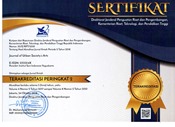'Ora Minggir Tabrak' Electronic Dance Music (EDM), a Montage of The Time-Image
Abstract
Electronic Dance Music (EDM) is a music genre which has been perceived in negative way because closely related to night life in which alcoholic drinks and illegal drugs. The beatings of the rhythm presented can arouse a desire to shake the body, giving instant pleasure to escape from the weariness of life. Although it could be said that this music genre is able to help the listeners to forget “the problems” of life, however, it is very rarely that the academic circle looked into this music genre and make it as a subject of interesting studies. This article is written out of subjective observations in social sphere on subjects containing a lot of secrecies and initially considered as a taboo to be discussed. The existence of EDM in line with the technological developments as montage of the time-image related with complexity of social relations, attempting to embark on a new identity in power, politics, and ideological trappings. The phenomenon comes into sight specifically in the song of “Ora Minggir Tabrak”,literally means if you get on my way I will hit you, a soundtrack of Ada Apa Dengan Cinta 2feature film. And it obviously could be seen in talent hunting for EDM musicians program broadcast by Net TV (the ReMix), and several other big events with internationally standard organized annually, such as DWP (Djakarta Warehouse Project); and Dreamfield at GWK Bali, which are worth-discussing amidst the hustle and bustle of music market in Indonesia.
Keywords
Full Text:
PDFReferences
Bennett, A. (2000). Popular Music and Youth Culture: Music, Identity and Place. Mobile Media & Communication. https://doi.org/10.1177/2050157912460033
Cohen, S. (2011). Folk devils and moral panics: The creation of the Mods and Rockers. Folk Devils and Moral Panics: The Creation of the Mods and Rockers. https://doi.org/10.4324/9780203828250
Fiske, J. (2010). Television culture: Second edition. Television Culture: Second Edition. https://doi.org/10.4324/9780203837153
Hebdige, D. (1986). Postmodernism and ‘The Other Side.’ Journal of Communication Inquiry. https://doi.org/10.1177/019685998601000206
Hebdige, D. (1993). From culture to hegemony. The Cultural Studies Reader.
Hebdige, D. (1995). Subculture: The Meaning of Style. Critical Quarterly. https://doi.org/10.1111/j.1467-8705.1995.tb01063.x
Heryanto, A. (2008). Popular culture in Indonesia: Fluid identities in post-authoritarian politics. Popular Culture in Indonesia: Fluid Identities in Post-Authoritarian Politics. https://doi.org/10.4324/9780203895627
Siokou, C. (2002). Rave culture. Youth Studies Australia.
St John, G. (2006). Electronic Dance Music Culture and Religion: An Overview. Culture and Religion. https://doi.org/10.1080/01438300600625259
Strinati, D. (2005). An Introduction to Theories of Popular Culture. PsycCRITIQUES. https://doi.org/10.1037/021123
Van Havere, T., Vanderplasschen, W., Lammertyn, J., Broekaert, E., & Bellis, M. (2011). Drug use and nightlife: More than just dance music. Substance Abuse: Treatment, Prevention, and Policy. https://doi.org/10.1186/1747-597X-6-18
DOI: https://doi.org/10.24821/jousa.v5i2.2185
Refbacks
- There are currently no refbacks.

This work is licensed under a Creative Commons Attribution 4.0 International License. ISSN 2355-2131 (print) | ISSN 2355-214X (online).






